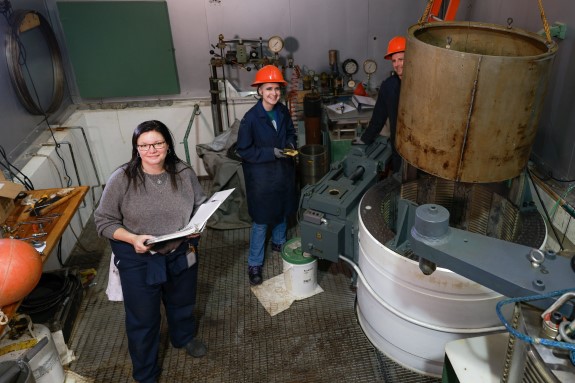February 5, 2024
Before the Canadian Armed Forces deploys ocean technology, such as acoustic arrays to listen underwater, or new materials for submarines, it goes through a lot of testing.
Alexandra McLeod, a mechanical engineering technologist and leader of the maritime information systems and technology (MIST) group at the DRDC Atlantic Research Centre, explains how they use a high-pressure tank to ensure underwater equipment can withstand the pressure of the ocean depths.
“It’s a massive tank made of high yield steel two inches [5 centimetres] thick and it sits in a pit where we can lower in test subjects,” McLeod says, adding that the tank can simulate conditions as deep as 6,000 metres underwater, with pressure up to 58,600 kPa (8,500 psi).

Alexandra McLeod, a mechanical engineering technologist and leader of the maritime information systems and technology (MIST) group at the DRDC Atlantic Research Centre, demonstrates how the lab’s high-pressure tank works to test underwater equipment. Credit: Steve Berry / Defence Research and Development Canada
The tank is approximately 1.2 metres in diameter and 2.5 metres high and test specimens can be almost as large as the tank at 0.9 metres by 2.1 metres. There are feed-throughs which allow test specimens to be monitored or powered electrically, pneumatically, or hydraulically as required, while the tank is pressurized.
Depending on what needs to be tested, McLeod’s group can fill the tank with saltwater, or even mineral oil.
“If we see buckling on the test subject on the gauges on the outside, we can determine where it deviated and use that information to improve the design,” McLeod explains.
The goal is to ensure the equipment is hermetically sealed, meaning it is both airtight and watertight, and durable enough to withstand the immense pressure of the ocean depths.
“This capability is very unique on the east coast and we share it with contractors in industry, academia and working with allies in The Technical Cooperation Program,” McLeod explains.
The Technical Cooperation Program is an organization which enables cooperation on defence science and technology between Australia, Canada, New Zealand, the United Kingdom, and the United States.
